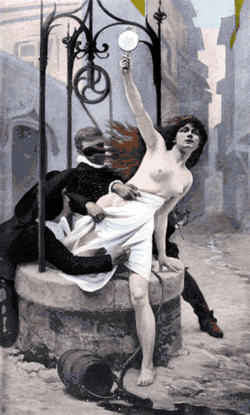Truth Coming Out of Her Well
| Truth coming out of her well | |
|---|---|
|
| |
| Artist | Jean-Léon Gérôme |
| Year | 1896 |
| Medium | Oil on canvas |
| Dimensions | 91 cm × 72 cm (36 in × 28 in) |
| Location | Musée Anne de Beaujeu, Moulins, Allier |
La Vérité sortant du puits armée de son martinet pour châtier l'humanité (English: Truth coming from the well armed with her whip to chastise mankind) is an 1896 painting by the French artist Jean-Léon Gérôme.
Overview
In 1895, Gérôme had painted a similar work, Mendacibus et histrionibus occisa in puteo jacet alma Veritas (English: The nurturer Truth lies in a well, having been killed by liars and actors).[1] It has been suggested that both paintings (like a similar, later work by Édouard Debat-Ponsan) were a comment on the Dreyfus affair.[2][3] It has also been suggested that the painting is an expression of Gérôme's hostility towards the Impressionist movement, to which he was violently opposed.[4] However, in a preface that Gérôme wrote for Émile Bayard's Le Nu Esthétique, he refers to the influence photography had had upon painting:
La photographie est un art. La photographie force les artistes à se dépouiller de la vieille routine et à oublier les vieilles formules. Elle nous a ouvert les yeux et forcé à regarder ce qu'auparavant nous n'avions jamais vu, service considérable et inappréciable qu'elle a rendu à l'Art. C'est grâce à elle que la vérité est enfin sortie de son puits. Elle n'y rentrera plus.[5] |
Photography is an art. It forces artists to discard their old routine and forget their old formulas. It has opened our eyes and forced us to see that which previously we have not seen; a great and inexpressible service for Art. It is thanks to photography that Truth has finally come out of her well. She will never go back. |
The expression refers to a widespread translation of an aphorism of the philosopher Democritus, "Of truth we know nothing, for truth is in a well [lit. in an abyss]."[6] The nudity of the model refers to the expression 'the naked truth'.[7] According to his biographer Charles Moreau-Vauthier, Gérôme slept with the painting above his bed and was found after his death with his arm stretched out towards it in a gesture of farewell.[8]

The painting was exhibited at the Salon in 1896.[9] Since 1978 it has been part of the permanent exhibition at the Musée Anne de Beaujeu in Moulins, France.[4]
See also
References
- ↑ The Academy. J. Murray. 11 May 1895. p. 409.
- ↑ Pouillon, François (2012). Dictionnaire des orientalistes de langue française (in French). KARTHALA Editions. p. 466. ISBN 9782811107901.
- ↑ Brauer, Fae (2013). Rivals and Conspirators: The Paris Salons and the Modern Art Centre. Newcastle upon Tyne: Cambridge Scholars Publishing. pp. 205–6. ISBN 9781443863704.
- 1 2 http://www.mab.allier.fr/2045-les-collections-permanentes.htm
- ↑ Bibliothèque nationale (France) (1997). Autour de Turandot (in French). Bibliothèque nationale de France. p. 33.
- ↑ Diogenes Laertius. Lives of Eminent Philosophers. IX, 72. Perseus Project, Tufts University.
- ↑ Noël, Benoît; Hournon, Jean (2006). Parisiana: la capitale des peintres au XIXème siècle (in French). Paris: DISLAB. p. 147. ISBN 9782952721400.
- ↑ Moreau-Vauthier, Charles; Gérôme, Jean Léon (1906). Gérôme: peintre et sculpteur (in French). Hachette. p. 6.
- ↑ Ackerman, Gerald M. (1986). The life and work of Jean-Léon Gérôme: with a catalogue raisonné. Sotheby's. p. 276. ISBN 9780856673115.
External links
- Musée Anne-de-Beaujeu & Maison Mantin (2012). "La Vérité Est au Musée!" (PDF). Musée Anne-de-Beaujeu. Retrieved 3 Apr 2018. — A pamphlet on the painting from the Musée Anne-de-Beaujeu (in French)